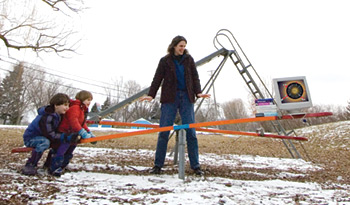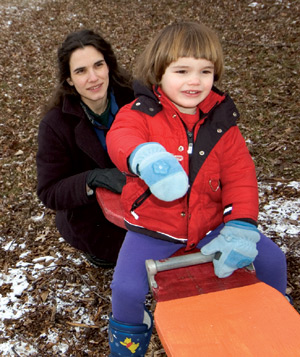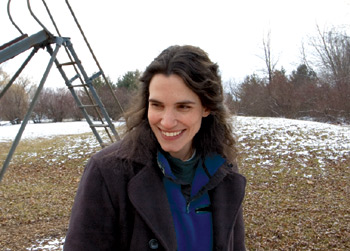Breaking for families
Women physicists find taking a leave is often hazardous to their career.
by Kendra Snyder
|
From the time she earned her PhD, it took almost a decade for Elizabeth Freeland to get where she is now, crunching numbers for Fermilab's Theoretical Physics Department on the third floor of Wilson Hall. After receiving her doctorate in condensed-matter physics from Johns Hopkins University in 1996, Freeland took a five-year career break for motherhood before returning to the field. She was met with a series of hurdles built by her absence. "There's this mindset that if you take time to do anything but physics, then you're not serious," Freeland says.
Geography limited Freeland's initial job search. Her husband, also a physicist, accepted a job at Brookhaven National Laboratory. Freeland followed, unable to find a job in her own field. Shortly afterward, she followed again when her husband accepted a job at Argonne National Laboratory near Chicago. Freeland always wanted to have children, and she says she didn't want to push her personal dream aside for a professional one. So in 1999, the couple had their first child, Raymond. "I didn't want to have children when I was 40," Freeland says. "I wanted to have them in my late 20s or early 30s, which is not the best time in terms of an academic or science career."
After giving birth to her daughter, Eleanor, in 2002, Freeland renewed her job search. A full-time job demanded research experience, so after sending out numerous letters looking to help labs on "small projects," she came to Fermilab hoping to collaborate on summer research. Although Freeland said the lab's staff was encouraging, she needed a grant to support her research. And the grants required her to have a full-time affiliation with less than a five-year break after graduate school. As a mother of two and a part-time physics teacher at the School of Art Institute of Chicago, Freeland had neither. The search for a grant came up empty. "If I couldn't get a grant, I couldn't have day care, and if I couldn't get day care, I couldn't do the work," she says.
|
Still the minority
Whether for motherhood, family needs, illness, or other reasons, career breaks can be detrimental to the livelihood of research physicists and scientists on tenure tracks at universities. Long work weeks, grants that assume an unbroken career path, and a disdainful attitude directed at scientists who leave the field for an extended period of time can make a physicist's return to the lab difficult, and sometimes impossible. "A gap in the résumé is viewed as suspicious," says University of Colorado Research Associate Sandra Laursen, who is working on a National Science Foundation ADVANCE project. ADVANCE grants are meant to increase the representation and advancement of women in academic science and engineering careers. Laursen continues: "Science career paths tend to be fairly linear and constrained, and people who are not following that path have a hard time getting back on it."
Although men also take breaks from scientific careers, women are most likely to face the decision to do so, some with "heartbreaking" stories, Laursen says. "There was one woman whose husband had brain cancer," she says. "She just needed to be home when her husband was dying. You can't fault that choice, but to take that hit to your career because of it is pretty tough."
The most common reason women take a leave from their jobs is related to a conflict between the biological clock and work demands, says Joan Williams, Distinguished Professor of Law and director of the Center for WorkLife Law at the University of California's Hastings College of the Law. WorkLife Law is a research and advocacy center in San Francisco that aims to spur conversation about families and their experiences in the work- place. Through her work there, Williams has written extensively about discrimination against women in the workplace, including Unbending Gender: Why Family and Work Conflict and What To Do About It.
Women are disadvantaged in science careers because of the path they're expected to follow after earning their PhDs, Williams says. According to the American Institute of Physics, the average age at which physicists earn their PhDs is 29. "In science you have to complete a postdoc, so if you wait until you get tenure, you're much more likely to be infertile," Williams says. "The track assumes an ideal worker doesn't take time off for child bearing. Women in science have trouble even taking maternity leave."
Those difficulties could be partly responsible for the field's lack of women. Although more women are earning physics PhDs, the gap between physics and other fields is becoming wider, according to a 2005 study conducted by the American Institute of Physics. In 2003, women earned just 18 percent of the PhDs in physics compared to about 45 percent in the biological sciences. However, this reflects a steady increase from 1972-73, when 3 percent of physics PhDs were earned by women.
"The climate for women is better, but not anywhere near where we'd like it to be," says Judy Franz, Executive Officer of the American Physical Society (APS). After doing a postdoc in Europe and giving birth to her son, Franz worked part-time for three years before she was able to "climb out of the hole" and secure a faculty position at Indiana University at Bloomington in the early 70s. "I had people tell me, ‘Don't you think you're destroying the life of your child?'" she says. "It was an entirely different climate then."
Although the idea of a working mom is now accepted, Franz says troubles for mothers in the science field remain. "One of the hardest challenges is having a family and being a physicist," Franz says. "Some people think it's natural that men shouldn't have to participate in the family. A lot of men do now, but there are old-timers around that think unless you're working 80 hours a week, you shouldn't do physics. That's very hard on women who would like to have a family."
 |
Hourly demands
Ruth Howes considers herself one of the lucky ones. When the Marquette University nuclear physicist was at Columbia University for graduate school, she did the unthinkable for a female physicist of the time–she had a baby. "You didn't get pregnant in grad school," she says. "I tried to hide it and then begged them to please, please let me work." Fortunately, Howes' advisor, C.S. Wu, didn't complain when Howes returned to the lab a month after the delivery, diapering her child on the lab table. Howes battled the odds again when after four years of part-time work and one more pregnancy, she secured a faculty position at Ball State University.
Stereotypes about women in the field, especially mothers, stayed with her. "It was about who could work hardest and who could be the tiredest," Howes says. "The physics field as a whole needs to take a deep breath and stop looking at itself as a religion and recognize that doing physics is a job and people need to balance work and other aspects of life."
The average university faculty member works more than 50 hours a week and 95 percent of American mothers aged 25-44 work less than 50 hours a week year-round, says WorkLife Law's Williams. "There's a really dramatic mismatch between the workforce and the workplace," she says. "You don't have to do much more than design a full-time job at 50-plus hours a week to wipe mothers out of the labor pool, thereby wiping a majority of women out of the labor pool."
Ultimately, that workforce mismatch forces scientists to choose between a family and a career. For now, condensed-matter physicist Elvira Badica chooses family. For the past year and a half, Badica has stayed at home to take care of her two children. After she had her first child as a graduate student at the University of Illinois at Urbana-Champaign, Badica went on to complete her postdoc at Argonne National Laboratory. Around the time Badica's second child was born, she stayed in Illinois while her husband moved to New Jersey to complete his own postdoc. But suddenly, mixing research and family have become too much to juggle by herself.
"I thought it was the right thing to do for the sake of the family being together," Badica says. "Research involved more time, family involved more time, and it was hard to balance." She expects stability soon. Within a year, the family plans to reunite in Virginia, where Badica's husband will complete another postdoc at the University of Virginia. The move also could allow Badica another stab at the science she left behind. In Virginia, Badica hopes to become a student once more, earning an education degree and eventually teaching physics. She doesn't expect an easy re-entry to the field, but says she hopes that a third option will present itself in the physics-versus-family dilemma: the opportunity to do both.
|
Finding a "loophole"
Fermilab's Freeland eventually earned enough money from teaching at the Art Institute to pay for day care while conducting part-time research. Then she found a "loophole"–a grant from the American Association of University Women did not require full-time affiliation with an institution, and did not exclude those out of graduate school for longer than five years. Her application was accepted, and the one-year grant allowed her to start at the lab full-time in July, working on Lattice QCD calculations. QCD, or quantum chromodynamics, is a theory that describes the strong nuclear force. Now collaborating with the Lattice QCD group, Freeland studies through numerical analysis QCD's effect on the decay of subatomic particles.
Grants that cater to scientists who take career breaks are extremely limited, but they do exist. In addition to the American Association of University Women, the Sloan Research Fellowship also accommodates those who take career breaks. Similar grants are being created, such as the American Physical Society's M. Hildred Blewett Scholarship. The one-year award of $45,000 is designed to assist women who have interrupted their research careers because of family demands. It was made possible by a bequest from M. Hildred Blewett, a female particle accelerator physicist who died in 2004. "Everyone was very happy to see this award created–and who knows, maybe it will inspire other donors," says APS Education Programs administrator Sue Otwell.
"If I couldn't get a grant, I couldn't have day care, and if I couldn't get day care, I couldn't do the work."
Additional grants are encouraging but help only a small number of women to re-enter the field, Freeland says. A real solution would go much deeper, by scrutinizing hiring methods, changing cultural attitudes, and encouraging communication. "You should be able to sit down at a lunch table and say ‘When is a good time to have children, or how can I deal with this?'" she says. "You should be able to ask that question to a group of physicists and not have it looked at as a negative."
The APS Committee on the Status of Women is trying to help women deal with hurdles in their careers through a series of workshops on communication and negotiation skills. WorkLife Law will offer training in handling the disadvantages women face in the workplace. This approach to cultural education also should be adopted at universities and institutions to change some of the deeply rooted stereotypes female scientists face, says APS's Franz. "People in positions of power and influence should speak out and say ‘Women physicists are important, and in order for them to participate we're going to have to make some changes,'" she says.
In addition to training, Williams suggests one quick fix to help scientist moms in the field: job shares. "There are always far more qualified applicants than can be hired, so why not divide a 50-to-60 hour-per-week job into two 20-to-30 hour-per-week jobs?" she says. "That is an easy solution and it could be done tomorrow."
A greater number of part-time jobs, however, won't work unless the stigma attached to them and to physicist mothers is erased, Freeland says. "Family issues need to be talked about more instead of brushing them aside," she says. "I made a lot of mistakes because I wasn't allowed to talk about the decisions I was making. Wanting to have children is independent of your ability as a scientist."
Click here to download the pdf version of this article.









